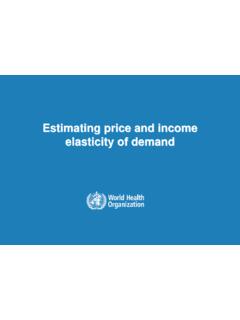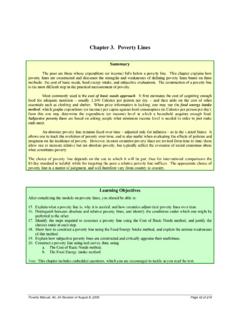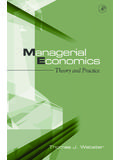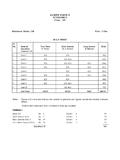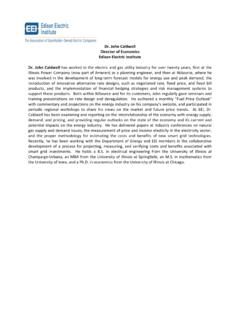Transcription of Estimating Automotive Elasticities from Segment ...
1 EstimatingAutomotiveElasticitiesfromSegm entElasticitiesandFirstChoice/SecondChoi ceDataRob ,2006 AbstractOfthesharelosttoonepro ductb ecauseofapricechange,diversionfractionsa rethefractionsofthatlostsharegoingtoeach oftheotherpro erexpressespro ducts,time-seriesdataisinsu erestimatesautomotiveelasticitiesbysp ecifyingthediversionfractionsusingcross- sectional d-elsKnowingpro ductdemand-priceelasticities(Hagerty,Car manandRussell,1988;Hauser,1988;Tellis,19 88)iscentraltomanycorp oratepro eci espro erentpro ducts,arealisticdemandmo delofteninvolvesmanymoreparametersthanca nb cientdatacanb esolvedbyplacingrestrictionsonthecross-p riceinteractionsinademandmo ,thehedonic,transformstheproblemofestima tingmanypro ductde-mandfunctionstotheproblemofestima tingasmallernumb ductsmightb esortedintosegmentsusingcross-sectionald atawiththepro ductdemandmo delsconstrainedtosatisfylogitassumptions withinandacrosseachsegment(KamakuraandRu ssell,1989;RussellandBolton,1988).
2 Butde ningsegmentsforwhichthelogitassumptionsa rerealisticisnearlyimp ossibleforsomemarkets( ,theautomotive.)Todevelopanalternativeap proachtoimp osingrestrictionsondemandmo d-els,notethatallpro ductloseswhenitsownpriceincreases(theown -elasticity), ducts(thediversionfraction.)Thisdiversio nfractionisfrequentlyindep endentoftheamountofthepricechangeandonly afunctionofthecross-sectionalsimilarityb etweendi er-entpro ducts(Bordley,1985).Furthermore,asthispa p er's rstsectionshows,standardeconomicconditio nsimplythatallincome-comp delcouldalsob erestrictedbysp ecifyingitsdiversionfractionsfromcross-s ectionaldatapriortoestimatingthemo ,considertheRotterdamdemandmo del(DeatonandMuell-bauer,1986)onaneconom ywithnpro ecifyingthediversionfractionspriortoesti matingthemo delontime-serieswouldreducethenumb erofparam-etersrequiringestimationfromn( n+ 2)(withn(n+ 1)parameterscorresp ondingtodemand-priceelasticities)to2n+ 1, erwillfo :size,paint,engine,interiorupholsteryetc .
3 ,therearemanywaysofde ningwhatconstitutesadistinctautomotive`p ro duct.'Forthepurp osesofcomp etitivepricing,thede nitionofwhatconstitutesadistinctpro ductmustdistinguishb etween vehiclesmadebydi erentvehiclemanufacturers, vehicleswithsigni cantlydi erentmarginalcosts, vehiclestargettedatdi neadistinctpro ductintermsoftwofactors:Fordiscussionoft hehedonicapproachandsomecriticisms,seeBe rndt(1990),Rosen(1974),Mendelsohn(1984). 2 thevehicle'splatform(whichsp eci escertainessentialmanufacturingat-tribut esofthevehicle) themarketingdivisionresp onsibleforsellingthevehicle(whichsp eci esthevehicle'stargetbuyergroupanditsmanu facturer.)Eachsp eci ccombinationofplatformanddivisionwillcon stitutewhatwecalladistinct`pro duct'(ornameplate.)(Someexamplesincludet heChevroletCorsica,thePontiacLeMans,theH ondaAccordetc.)Sincemanymanufac-turersow nseveraldivisions( ,GM'sNorthAmericanop erationsincludetheChevrolet,Pontiac,Olds mobile,Buick,Cadillac,GMCT ruckandSaturndivi-sions)andpro duceseveralplatforms,therearemorethan200 distinctpro ductsaregroup edintosevensegments( ,Economy,Small,Compact,Midsize,Large,Lux uryandSp orty) ,thePontiacParisienne,theOldsDelta88,the BuickLeSabre,theFordCrownVictoria, deloverthesegments(whichsp ec-i essevensegmentownelasticitiesandonemarke townelasticity.)
4 Marketinganalyststhen`explo de'theseaggregateforecastsintosp eci cforecastsab outhowthemorethan200pro ductswithineachsegmentwillfare,generally usingcross-sectionaldataonpro onsibilitymotivatesthefollowingvariation onthemetho d- ,sp eci callydataoncustomer rstandsecondchoicepro ductpreferences, erusesthistechniquetoestimatemorethan40, 000pro ;pjandYdenotepro ducti'sdemand,pro ductj'spriceandincomere-sp nesijandtheincome-comp ensatedelasticity,eij,bysij=@ qi@ pj+qj@ qi@ Y;eij=pjqisij(1)3 Ofthesalesrevenueswitchingoutofpro ductjgivenamarginalincreaseinj'sprice,de nethediversionfraction, ,theincome-comp ensatedfractionswitchingtopro ductiversusanyotherpro ductinthemarketM=f1:::ng,by:fij=wieijPk6 =j;k2 Mwkek j(2)De newM=Pj2 Mwjandde netheintramarketcross-elasticity,EMM,byD EFINITION1:EMM=Pj;i2M ;i6=jwieijwMSlutskySymmetry,( ,sij=sj i,foralli;j),neednotapplyforaggregatedem andmo erthereforeassumesthatalimitedversionofS lutskySymmetryholdsb etweenpro ductsindi erentmarkets, ,ASSUMPTION1:Foralli2M,Pk62 Mwieik=Pk62 Mpipksik=Pk62 Mpipksk i=Pk62 Mwkek iGivenAssumption1,thecriticalTheoremis:T HEOREM1:Let( 1::: n)solve:Xj2M ;j6=ifij j= iXj2M j=1 Thenwjej j+Xk62 Mwkek j= jwmEMMwieij=fij jwMEMMPROOF:Thebudgetconstraint(seeDeato nandMuellbauer,1986, )impliesXk6=j;k2 Mwkek j+wjej j+Xk62 Mwkek j=Xkpkpjsk j=0(3)andtheeconomichomogeneitycondition implieswieii+Xj62 Mwieij+Xj6=i;j2 Mwieij=Xjpipjsij=0(4)Substituting(3)in(2 )giveswieij= fij(wjej j+Xk62 Mwkek j);i6=j(5)Substituting(5)in(4)giveswieii +Xj62 Mwieij Xj6=i;j2 Mfij(wjej j+Xk62 Mwkek j)=0(6)4 UsingAssumption1in(6)giveswieii+Xk62 Mwkek i Xj6=i.
5 J2 Mfij(wjej j+Xk62 Mwkek j)=0(7)Ifallautomotivepro ductssustainedthesamemarginalp ercentagepricein-crease,thenthetotalsale srevenueswitchingfromonevehicletoanother wouldb eprop ortionaltoPjwjej j+Pk62 Mwkek cusonthefractionofthesediversionsasso ciatedwithsalesrevenueswitchingoutofpro ductj,de neDEFINITION2: j=wjej j+Pk62 Mwkek jPj2M[wjej j+Pk62 Mwkek j]Thus jmeasureshowelasticpro ductj'ssharedemandisrelativetothatofothe rautomotivepro nition2implies:Xj2M j=1(8)SubstitutingDe nition2into(7)gives i=Xj6=i;j2 Mfij ji2M(9)Thusthehomogeneityandaggregationc onditions,whenwrittenintermsofdi-version fractions,areequivalenttoaMarkovPro cesswiththediversionfractionsastransitio nprobabilitiesand (4)inDe nition1giveswMEMM= Xj2M(wjej j+Xk62 Mwkek j)SubstitutingintoDe nition2thengiveswjej j+Xk62 Mwkek j= jwMEMM(10)Equations(5)and(10)thenimplywi eij= fij(wjej j+Xk62 Mwkek j)=fij jwMEMM(11) ductswereknown,thenthemarketwouldinclude allpro ductsandequations(10)and(11)b ecome:wjej j= jwMEMM wieij=fij jwMEMM5sothatpro ductswerestronglyseparableandifeiYwaspro ducti'sincome-elasticity,thenfij=wieijPk 6=jwkek j=wieiYwjej YPk6=jwkek Ywjej Y=wieiY1 wjej Y i=wieiY(1 wieiY)Pkwkek Y(1 wkek Y)Hencetheelasticitiesb ecomewjej j= wjej Y(1 wjej Y)Kwieij=wieiYwjej ducesFrisch'sresults(1959).
6 3 ESTIMATINGDIVERSIONFRACTIONST heauthorhadaccesstoaquarterlysampleof40, 000carbuyers2whowereaskedtolistthecarthe yb ought(their rstchoice)andthecartheywouldhaveb oughtiftheir rstchoicecarwasmadeunavailable(theirseco ndchoice.)Thisdatacanb eusedtoestimatefijbymakingtheassumption: ASSUMPTION3:Thefractionofj'sp otentialswitcherswhowoulddiverttoi,qieij Pm;j2M ;m6=jqmemj, endixI I Ishows,thisassumptionholdsiftheincome-co mp ensatedde-mandmo deldescribingtheeconomyistheratioofmulti linearfunctionsofprice, ,ifqi=ai+Pnk=1aikgk(pk)+Pnj;k=1aij kgj(pj)gk(pk)b0+Pnk=1bkgk(pk)+Pnj;k=1bj kgj(pj)gk(pk)(12)wheregjisanarbitrarymon otonicallyincreasingfunctionofpro ductj'sprice,ai;aik;aij k;b0;bk;bj kareconstantsandaij k=bj k=0forj= ecialcasesofthismultilineardemandmo delare(I)Logitqi=aiieuiPnk=1bkeukwhereui decreaseswithpi,satis es(12)withgi=eui,aii=aii,bk= ,000buycarbuyersafewmonthsaftertheypurch asedtheirnewcar,buyersareaskedtolistthec artheyb :`Supp osethecaryoupurchasedwasnoto (carortruck)makeandmo delwouldyouhavepurchasedinstead?
7 'Thesamplewasstrati edtoensurethatastatisticallysigni cantnumb ,AsianandEurop eencollectedformorethantenyearswithnoalt erationinthe (I I)Dogitqi= 0eui+ i(Pnk=1euk)Pnk=1euk(1+Pnj=1 j)with i>0satis es(12)withgj=euj,aii= 0(1+ i),aij= 0 ifori6=j,bj=Pni=1aijandzeroforallotherpa rameters.(I I I)AdditivelySeparableSalesMo dels:qi=Pjaijgj(pj)satis es(12)withbk=bj k=0.(IV)TheQuadraticCostFunction:Ifp0isa numeraire,thenthecostfunction,c(p0;p1::: pn)=p0 Pijaij[pip0 ai][pjp0 aj]+ u,impliesaHicksiandemandmo dellinearinpriceforallpro ductsotherthanpro duct0(whichformsasp ecialcaseofI I I).(V)AMultilinearGeneralizedExtremeValu eMo del:qi=euiGi(eu1;eu2;:::eun)G(eu1;:::eun )withG(eu1;:::eun)=Pnk=1bkeuk+Pnj;k=1bj keujeukwithbj j=0satis es(12)withaii=bi;aiik= rstchoice/secondchoicedataislacking,amor egeneralwayofestimatingdiversionfraction sinvolvesconstructingmultiat-tributepro ductp ositioningmaps(Hotelling,1929;Economides ,1986;HauserandShugan,1983)fromcross-sec tionalinformationonpro , ,( 1::: n)canb ededucedfromsolving(8)and(9)bystandardte chniques4inMarkovChains(Ross,1972).
8 Then(11)sp eci esallcrosselastic-itieswithinthemarketup toascalingfactor, ductp ositioningmaps,aspaceofvectors,witheachv ectorhavingrargumentsrepresentingutility weightsforeachofrpro ductattributes,isde ductaredistributedamongallthevectorswhos eutilityweightswouldassignthatpro ducthigherutilitythananyotherpro duct.(Avariationofthistechniquedistribut es rstchoice/secondchoicefrequencies.)Oncet henumb erofp eoplewithvariousutilityweightsissp eci ed,diversionfractionsareeasilydeduced.(S uchmapscould,inprinciple,b eusedtoinferallelasticitiesbuttheauthorp referstousethemonlytoinferdiversionfract ions.)4 Sincethen+1equationsarelinearlydep endent,dropanysingleequationotherthanequ ation(8),andsolvetheremainingnequationsf orthe j' ,thissolutiontothenremainingequationsnec essarilysatis SCALING FACTORS & ,EI,andanoverallmarketownelasticity,EM, ductelasticities(Wold,1953), ,EM=Pi;j2 MpiqieijwM;wM=Xi2 Mpiqi(13)EI=Pi;j2 IpiqieijPi;j2 Iwi;wI=Xi2 Ipiqi(14)Thisconditionisplausiblesinceco mp etitorsineachsegmenthavehistoricallytend edtomatcheachother' ( ,EIb eingasimplearithmeticaverageruleoftheela sticities)cancauseerrorsofasmuchas25%.
9 Butempiricalresults(rep ortedinsection5) nitionsofsegmentandmarketown-elasticityi mplyXIwIEI wMEM= XIXj2I ;i62 Iwieij= wMEMMXj;i62I(j)fij jwhereI(j)denotesthesegmentcontainingpro ,EMM,iscomputablefromEMM= PIwIEI wMEMwM(Pj;i62I(j)fij j)(15)5 Fortheautomotiveexample,theb estestimatesofEIandEMcamefromtheestimati onofthesegment-leveldemandmo del:QI=XI JaI JpJ+bIYwhereaI ductswereaggregatedintosevensegments:eco nomy,small,compact,mid-sized,large,luxur yandsp , delestimable,itwasnotedthataI JaJJequalledthefractionofbuyersinsegment Jwhowouldswitchtopro ductsinsegmentIifallpro eestimatedfromthe ensatedsegmentelasticitiescanb etweensegments( (PIwIEI wMEM))equalsthefractionofsalesthatwoulds witchb etweensegmentsgivenapricechange(Pj;i62I( j)fij j)multipliedbythenumb erofsalesthatwouldswitchfromonepro ducttoanothergivenapricechange(wMEMM).Gi ven(15),equation(11)sp eci :wjej j= jwMEMM+Pk62 Mwkek jPk62M ;j2 Iwkek j(wMEMMXi62I ;j2 Ifij j+wIEI)PROOF:SeeApp nethefractionofsegmentIswitcherswithseco ndchoicesinsidesegmentI, ,segmentI'sexclusivity,byFI=Pi;j2I ;i6=jfij jPj2I jDe nesegmentI'sshareofallsalesrevenuedivide dbyitsshareofp otentialswitchersalesrevenue, ,itsloyalty,byLI=Pj2 IwjwPj2I jThentheaveragepro ductown-elasticityinasegmentisjustCOROLL ARY1:eI=Pj2 IwjwIej j=EI wMEMMPij2 Ifij jwI=EI FILIEMMT husthedi erenceb etweenthepro duct'sown-elasticityinasegmentandthesegm entown-elasticityincreaseswiththesegment ' ductown- Elasticities , erconsiderstwoalternativeassumptions:ASS UMPTION2(a):Forj2M,Pk62 Mwkek j=wjej Y Iwhereej Yispro ductj'sincome-elasticityand Iisasegment-sp eci (DeatonandMuellbauer,1986)withresp ecttopro j= jwMEMM+wjej YPk2 Iwkek Y(wMEMMXi62I.)
10 J2 Ifij j+wIEI)Analternativeassumptionis9 Table1:ELASTICITIESBYSEGMENTA ssump-CarSegmentCarLineElasticities(ej j)tionSegmentElasticity(EI)MINAVEMAXLIFI 2(a) (b) (a) (b) (a) (b) (a) (b) (a) (b) (a) (b) (a)Sp (b) (EM) (EMM) (b):Forj2M,Pk62 Mwkek jwjej j=1 I Iwithineachseg-mentIInotherwords,thefrac tionofbuyerswhoswitchoutofthemarketisthe sameforallpro endixI Inotes,thisimplieswjej j= jPj2I jwIeIj2 IThisformulaindicatesthatifpro ductjhastwicethenumb erofswitchersaspro ductkforj;k2I,thenthenumb erofsalespro ductjlosesgivenap ercentagepriceincreaseistwicethenumb erofsalespro ductklosesgivenap TO THE AUTOMOBILE MAR-KETT hesegmentown-elasticitiesvariedbyab out30%overtherangeoftheir95%con rstchoice/secondchoicedatadescrib ethep opu-lationofcarbuyersexactly,thentheseco n denceintervalsimplycon denceintervalsoverthepro othassumptions2(a)andunder2(b).Theloyalt yindexishigherfor10higherpricedpro ducts(aswouldb eexp ectedsincehigherincomebuyersarelessprice -sensitive).
